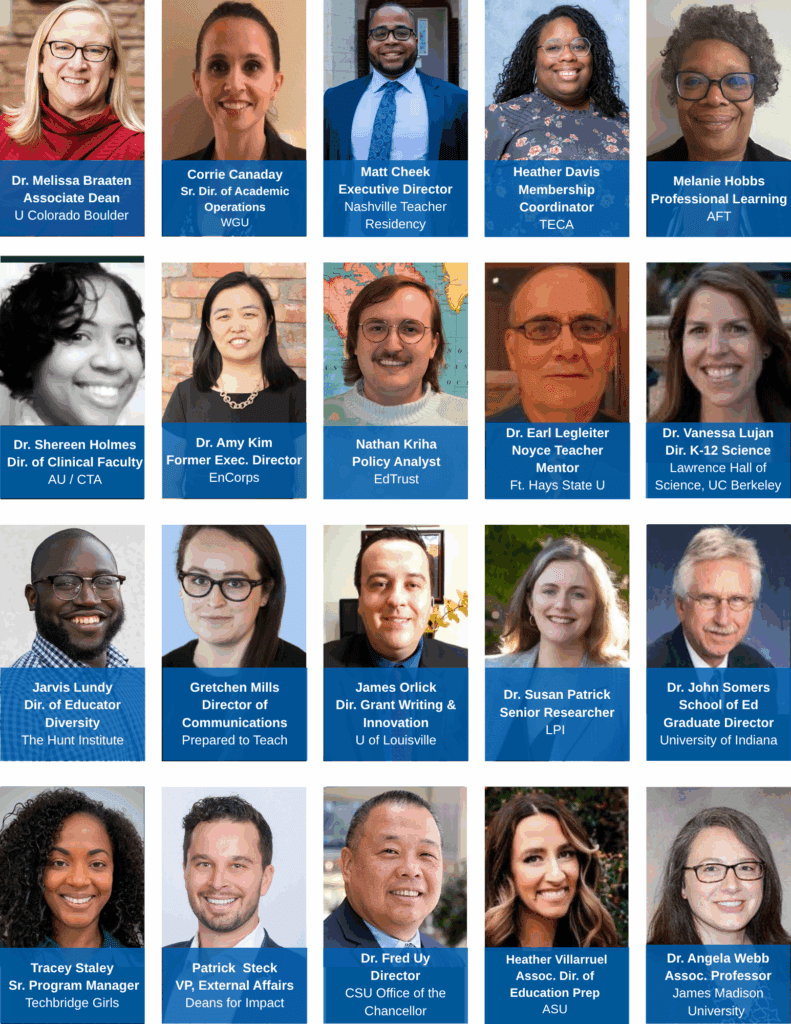Teaching often begins with a dream – a dream to do something transformative for children, for society, and for the future.
Aspiring educators are ready to lead the next generation of STEM learners—but too often, the pathways that would take them from dreaming to teaching remain out of reach. Dream to Teach explores how we can unlock this potential by strengthening, expanding, and sustaining preparation pathways that help every aspiring teacher reach the classroom—and thrive once there.
Over the past decade, enrollment and completion in teacher preparation programs have dropped sharply, even as nearly one million paraprofessionals and school-based staff represent an untapped source of future teachers. Many who dream to teach face financial, structural, and cultural barriers that make entering—and staying in—the profession increasingly difficult.
By building more accessible, inclusive, and high-quality pathways, we can ensure those who dream to teach become the educators who inspire the next generation of STEM leaders.
Grounded in Beyond100K’s Getting Smart research and insights from our Dream to Teach Brain Trust, this report examines:
- The current landscape of teacher preparation—its inequities, innovations, and areas of opportunity.
- What makes high-quality preparation models work, from paid clinical experiences to culturally responsive mentorship.
- Emerging models like residencies, Grow Your Own programs, and Registered Apprenticeships, that demonstrate promising results but need sustained investment and research.
Together with universities, districts, nonprofits, and policymakers, Beyond100K is mobilizing a field-wide effort to transform how we prepare and support future educators. The Dream to Teach report outlines seven key recommendations to guide that transformation:
1. Invest boldly in high-impact teacher preparation pathways to ensure long-term sustainability and affordability.
Paid clinical models such as residencies, apprenticeships, and Grow Your Own programs can transform access and quality, yet sustainability remains elusive. Stable, recurring public investment, akin to medical residencies, must replace short-term grants or purely philanthropic support. Programs like the National Science Foundation’s Noyce Scholarships and New Mexico’s funding of teacher residencies show what durable funding for STEM preparation can look like.
2. Ensure every candidate experiences supports that foster belonging and success.
Holistic supports should be considered a core component of preparation, not a luxury. Programs that integrate well-being, academic, and financial supports, such as the Nashville Teacher Residency’s wraparound supports and WGU’s depth and breadth of financial aid, demonstrate the outsized effects of small, consistent investments in student persistence.
3. Make culturally responsive mentorship a pillar of every program.
Mentorship that affirms identity and fosters belonging is one of the strongest predictors of teacher effectiveness and retention. Networks must professionalize and fund mentorship roles while developing shared frameworks rooted in cultural responsiveness, like those modeled by EnCorps, City Teaching Alliance, and the Center for Black Educator Development.
4. Band together to spread effective preparation models.
Collective learning and knowledge-sharing networks can move bright spots from isolated sites to systemwide adoption. Beyond100K was founded on the belief that we solve our greatest challenges together, and our network is poised to lead this work in partnership with initiatives across the field, such as Deans for Impact, the Pathways Alliance, and the NSF-funded Teacher Preparation for Rural STEM Teacher Persistence and Retention, that illustrate the power of coalescing around evidence and data to support and scale quality.
5. Prioritize research on pathway effectiveness and candidate retention.
Emerging models, particularly apprenticeships, demand rigorous research. Coordinated, longitudinal studies should document outcomes to identify which design elements drive retention, effectiveness, and diversity. Research partnerships like New America’s Grow Your Own Research Agenda and Beyond100K’s Brain Trust model lay the groundwork for this evidence base.
6. Prepare teachers to use emerging technology and partner with the STEM industry to inspire and develop the next generation of future-ready STEM leaders.
As the STEM workforce evolves, preparation programs must equip teachers to integrate emerging technologies, model responsible AI use, and connect students to evolving career pathways. Efforts like Colorado’s Teacher Externship Program underscore the value of educator-industry partnerships that strengthen relevance and innovation in teaching.
7. Create the conditions that allow more people to dream to teach.
Expanding recruitment pipelines requires changing the narrative about teaching’s prestige and promise. Programs such as UTeach, EnCorps, and Arizona State University’s paraprofessional-to-teacher initiatives prove that tapping school-adjacent talent and STEM students and professionals grows the pool of future educators. Strategic data systems must accompany recruitment efforts to ensure equity and precision in meeting teacher workforce needs.
Thank You to Our Brain Trust Members!
A dynamic group of leaders shaping the early discovery phase of Dream to Teach by guiding research, surfacing insights, and amplifying field-wide learning.
